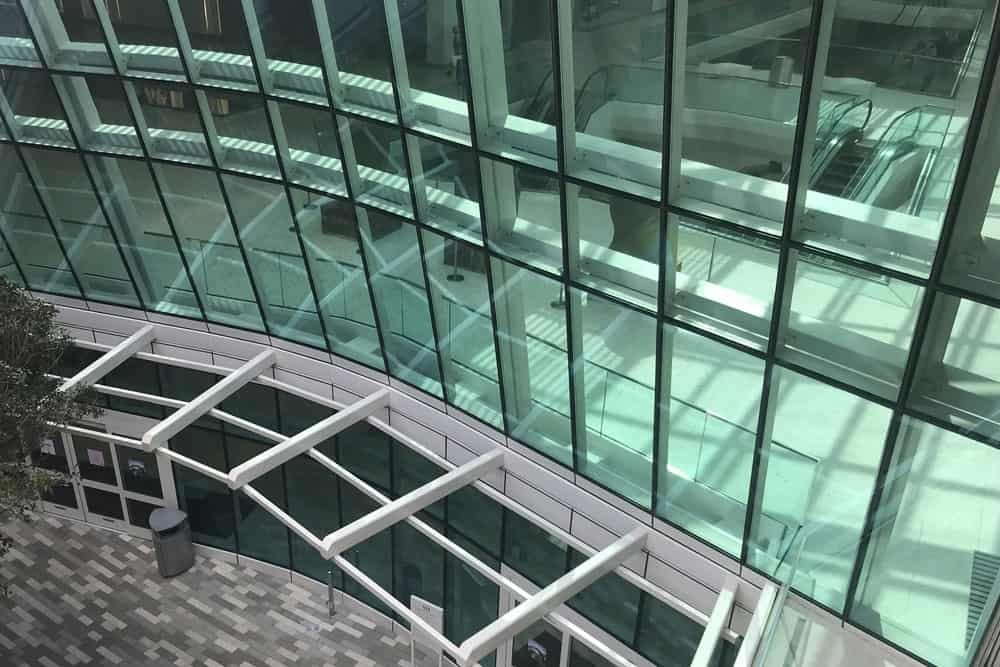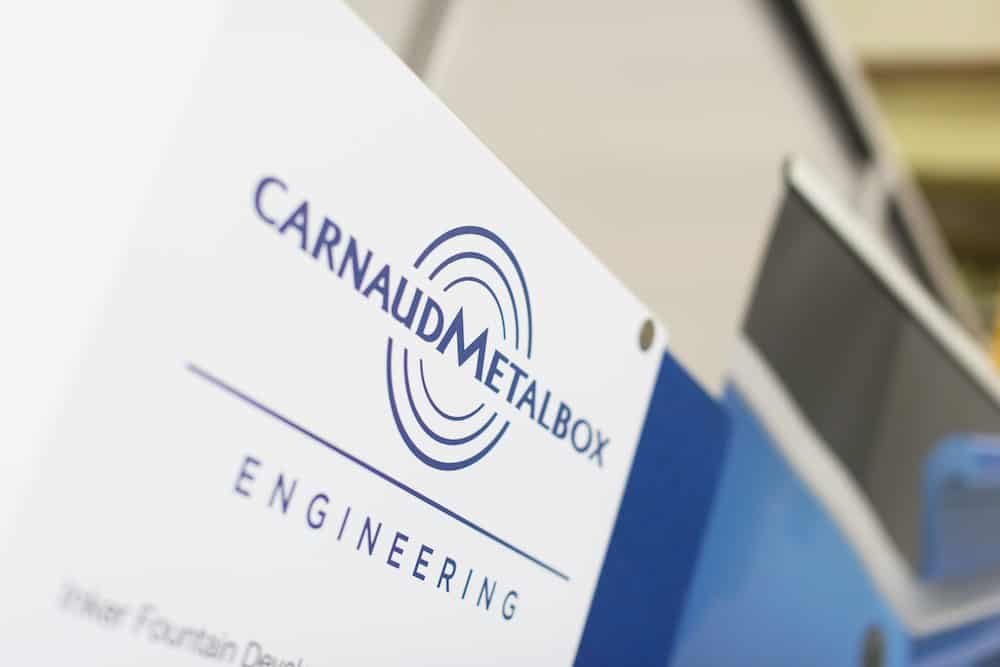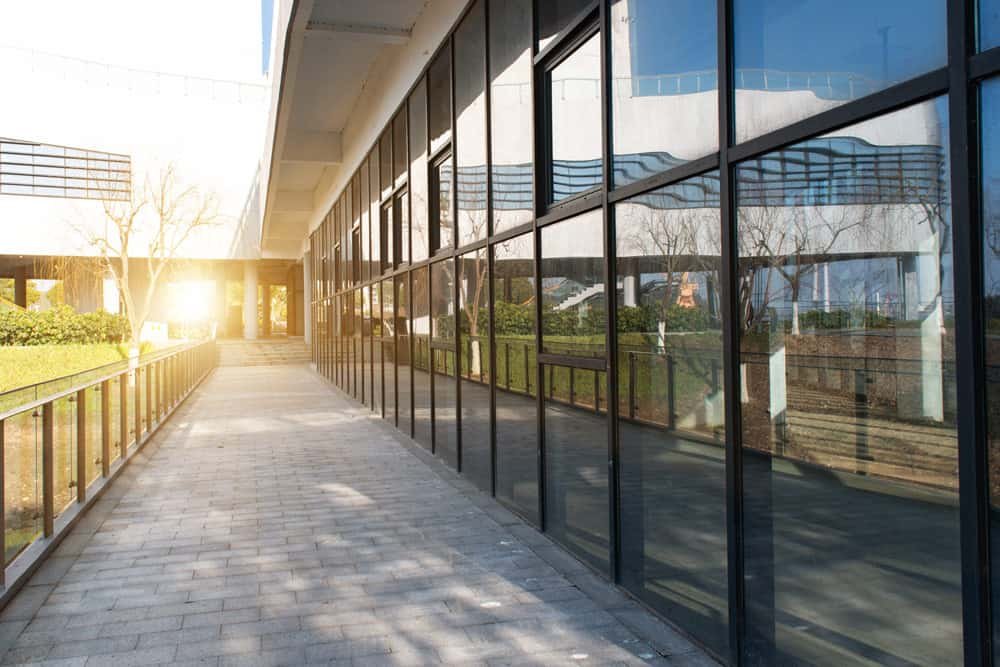Aluminium & Glazing team up for the Glen Nursing Home extension!
Based in Baildon, Glen Nursing Home underwent the construction of a new extension. This extension is to create a communal seating area for the residents to enjoy just in time for the summer months.
D.C. Liptrot won the tender to build the extension for Glen Nursing Home and entrusted Crucial on behalf of the curtain walling and aluminium windows. This involved both our aluminium and glazing teams who fell hand in hand on this project. As this was a new build it mean this job included fabricating and installing from scratch.
The intended look was fresh and welcoming from the inside whilst being sleek and modern from the exterior. The aesthetics of this project were important as it is needed to match the already prestige building.

The Crucial team partnered with Exlabesa for the use of the following products, KLW Curtain Walling System, KSF Commercial Door System and KC75 Window System, these products were then powder coated in RAL 7016 which is a stunning dark grey to give the clean look that was intended.
The curtain walling was used all the way around the extension to bring more light to the interior to brighten the space and showcase the exceptional view of the surrounding area. This also means stunning lighting during the summer and a cosy view whilst staying warm in the colder months.
We were able to manufacture all the glass used on this project inhouse at Crucial. The glazed unit’s are anti sun, toughened glass forming a 28mm double glazed unit. We used anti sun glass tinted grey to eliminate glare from the sun whilst still letting enough light in to feel bright.
Crucial Engineering are proud to work with customers all over the UK within multiple different sectors. We’re experts in Aluminium, Automation and Glazing, specialising in creating safe and secure access solutions. We secure your world!

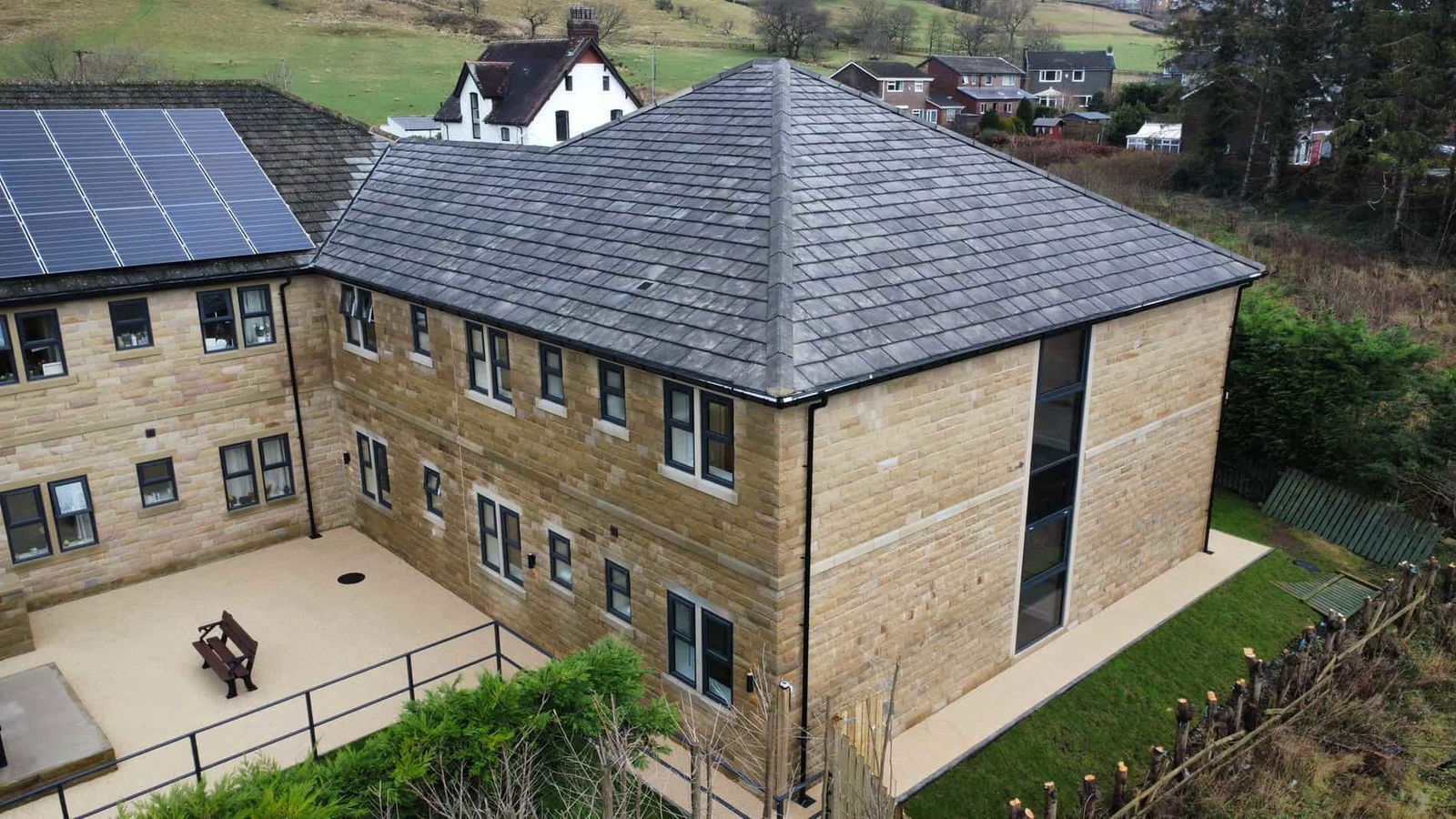
What is curtain walling?
Unless you work in construction or project, manage the construction and build of large buildings, high rise towers, and skyscrapers, curtain walling might not be a term you’re too familiar with.
However, curtain walling is all around us, and at Crucial Engineering, we manufacture and install a variety of curtain wall systems across the UK.
But what is curtain walling, and why is it important to the structure of a building?
What is curtain walling?
Curtain walling is a non-structural fabricated aluminium cladding system, found on the external walls of large multi-storey buildings.
It is a lightweight material that is easy to install, and can be glazed, opaque, or include infill panels,and these aluminium systems are easy to transport and simple to manufacture.
Curtain wall systems ultimately help to separate the interior from the exterior; however, it’s important to understand that curtain walling does not support any structural elements in a building and cannot have any weight placed upon it, other than the panelling itself.

Visually attractive facades
Curtain walling is mainly designed and manufactured for high rise buildings due to their exposed position, and in all situations and across all projects, curtain walls must meet extremely strict regulatory requirements.
A style that is widespread for use on tall buildings in cities around the world due to its flexibility and custom designs, curtain wall systems can be manufactured and installed as bespoke curtain walls, or they can be “off the shelf” systems.
Aluminium is a versatile and malleable material, which we can fabricate to be used in a wide range of spaces and moulded into innovative shapes and sizes.
From curved facades, geometrically shaped windows, multi-coloured powder-coated finished we can, and do, offer it all.
Benefits of curtain wall systems
Curtain walling can:
- Provide additional weather protection to buildings
- Reduce solar transmissions
- Be as flexible as you require
- Withstand building sway and thermal expansion and contraction
- Create a barrier to water and wind penetration
- Provide attractive exterior aesthetics
- Provide fire, smoke, and acoustic separation
- Accommodate movement and deflection
Curtain walling is also affordable and cost-effective both in the short and long term, it is energy efficient due to their ability to resist air and water infiltration, helping to reduce costs on heating, cooling, and lighting.
But above all, they are attractive and modern-looking systems for today’s buildings.
Types of curtain walling
There are two types of curtain walling facades available:
Stick systems – these systems are installed piece by piece on-site, where glazing or panelling is then inserted into frames from either the inside or out. These frames can also provide lateral resistance while allowing for thermal movement.
Unitised systems – these systems are prefabricated in sections off-site. Delivered to sites in sections, these systems can often be preferred as they require lower installation time.
Spider Glass – Using point-fixed glass panels that are connected to the structure with metal fittings. These are often made from stainless steel to ensure of a robust frame. The design is visually strking with minimal framing obstruction, which offers a transparent facade. Often seen in more modern constructions, Spider Glass is becoming a popular choice in the industry for clients and businesses alike.
Double Skin or Double-Glazed – these typically have an exterior layer of glass and an interior layer, which creates an insulating air gap between them. The design creates a greater level of insulation and reduces noise transmission. It also has energy efficiency benefits which is a big priority for businesses, with meeting net zero and carbon emmision targets.
Structural Glazing – The use of structural silicone to bonds the glass directly to the framework, which eliminates the need for visible framing members. It creates a very sleek, modern and frameless apperance. This method typically requires extremley detailed levels of bespoke engineering and installation.
Types of infill panels
Infill panels can include:
- Vision and non-vision glass
- Aluminium
- Stone/Brick
- Terracotta
- Louvres/vents
- Fibre-reinforced plastic
Curtain walling can feature vast expanses of glass, allowing natural light into buildings, creating great working environments.
Curtain walling systems
There are three curtain wall systems to choose from. These include:
Face Sealed – these systems attempt to create the perfect seal; however, these systems inevitably fail due to pressure-driven moisture.
Water Managed – these systems are similar to pressure systems; however, there is no attempt to prevent water penetrating the outer seal, making the primary function of these systems to drain water, rather than allowing pressure equalisation. (Some water systems may include moisture drains to stop water from getting into the building.)
Pressure Equalised – these systems help to create a rebate between the internal and external gaskets, so there are no pressure differences between the outside and the rebate. Any rain that then penetrates the outer seal can then be drained away through the vents within the facades. Pressure systems block all external forces while keeping a building interior airtight. These are some of the most robust systems around.
Curtain walling is an important way to protect a building from the harsh external elements. Manufactured and installed in any size and design, curtain walling systems create unique, visually stunning exteriors, always.
If you’re looking for aluminium curtain walling installation and you would like advice on the best systems to suit your requirements, contact Crucial Engineering today.
Exploring the Benefits of Aluminium Curtain Walling
Like many industries today, innovation in the world of architecture is fast moving and competitive. Creating sustainable, visually appealing, and functional buildings is the aim for most modern construction and planning teams. In use since around the 1930’s, aluminium curtain walling has gained popularity and emerged as a prominent choice for architects and developers. This is mainly due to the versatile and sophisticated system it offers. With a plethora of benefits, contributing to the beauty, efficiency, and durability of modern structures, here, we explore the advantages of aluminium curtain walling and why it has become a preferred solution for contemporary construction projects.
Structural Stability and Integrity
Renowned for its lightweight nature, aluminium is easier to handle and install compared to other construction materials. Despite this, aluminium is remarkably strong and durable. This inherent strength, in combination with the structural design of curtain walling, ensures that an aluminium curtain walling system can withstand powerful environmental forces such as wind, rain, and even seismic activity, providing a safe and super stable building envelope. Allowing excellent ventilation, despite being highly weather resistant is why a aluminium curtain walling is such a popular choice for public buildings such as hospitals and universities. It keeps a healthy flow of air running throughout the building whilst at the same time protecting the building’s inhabitants from the elements.
Excellent Thermal Performance
Aluminium curtain walling systems are engineered to offer exceptional thermal insulation. This is crucial for maintaining comfortable indoor temperatures as well as minimising energy loss. Advanced thermal technology and insulating materials can be integrated into the design of aluminium curtain walling, helping to reduce heating and cooling costs. Increasing the overall energy efficiency of a building is a key requirement given by clients to many architects today and aluminium curtain walling often fits the brief perfectly.
The Flexibility for Beautiful Design
Aluminium curtain walling enables architects to work with a massive range of client briefs and can bring their most creative visions to life. Aluminium’s inherent flexibility allows for the creation of a variety of shapes, curves, and configurations, and is held in high regard for unique building design. Indeed, some of the most iconic buildings in the world have been constructed with an aluminium curtain wall as their exterior. The sleek and modern appearance of aluminium complements various architectural styles, providing a visually appealing façade that stands out in urban landscapes.
Durable yet Easy to Maintain
A huge benefit of aluminium curtain walling is that it wears incredibly well and requires minimal maintenance over its lifespan. Because aluminium has a natural resistance to corrosion, the façade retains its original appearance for decades. This type of endurance not only reduces ongoing maintenance costs in the short run, but also extends the life of the building in the long run which makes it an attractive investment for developers and property owners.
Natural Light and Energy Efficiency
With the ability to incorporate large glass panels into the design of a curtain wall system, this allows an abundance of natural light to flood interior spaces. With lots of focus today on health and wellness, the access to natural light in any building and workplace is a top priority when it comes to building design. Natural light enhances the occupants’ well-being by providing a more pleasant and open environment. It also reduces the need for artificial lighting during daylight hours. By maximising natural light, buildings with aluminium curtain walling can significantly reduce their energy consumption, contributing to energy efficiency and sustainability.
Faster Construction Timelines
Because aluminium curtain walls can be prefabricated offsite, and are incredibly lightweight, faster construction project timelines can be implemented when compared to other building methods. This helps to reduce labour costs, and management of workers, which further shortens the overall construction timeline, allowing buildings to be completed more quickly. This is especially valuable for commercial projects seeking a swift return on investment or when refurbishment turnaround times need to be fast to reduce the impact on customer experience or sales.
Contributing to Sustainability
Being one of the most highly recyclable materials in the world without compromising its quality, Aluminium is an eco-friendly choice for sustainable construction. Aluminium uses 95% less energy to recycle than to produce from raw material so is a truly sustainable material. Not only is aluminium curtain walling an attractive and modern option for building design, it’s use also demonstrates a commitment to reducing the environmental impact of construction projects and promoting a circular economy.
Crucial – The Experts Engineers of Aluminium Curtain Walling
We are proud to have an award winning team and have delivered some of the best aluminium curtain walling projects in the North of England. If you are exploring the benefits of aluminium curtain walling and want some expert advice about how it might support your building project, contact us today and our friendly team will be happy to talk things through.
Why is aluminium the material of choice in the commercial sector
Aluminium is now widely used throughout the building industry due to a series of natural properties and commercial benefits. It has become the dominant material in many aspects of building construction because of its flexibility and ability to meet highly custom requirements.Many new building developments including office space, public buildings and shopfronts will now feature aluminium throughout the structure including aluminium windows and doors, roofs and walls. It could also be the dominant material in stairs, railings, shelves and gates - plus many other applications.
This is due to the benefits that aluminium offers in building construction:
Aluminium is lightweight and strong
Aluminium has an excellent weight to strength ratio so it’s ideal for many purposes. Aluminium window frames are thin but also incredibly strong so they can comfortably and securely hold large windows in place. This makes aluminium ideal for modern building design including curtain walling and entrance doors.
Due to the strength of aluminium doors and windows, frames can be made much thinner than more traditional materials such as timber or PVC. This allows more space for glazing which brings further benefits such as increased natural light and eye-catching aesthetics.
Create a modern and eye catching building design
The fact that aluminium looks fantastic makes it an extremely popular material with architects and building designers. Adding aluminium window frames and doors instantly creates the look of an incredibly modern building with clean lines and flexible finishes.
This gives building designers much more freedom to create original structures that can include imaginative curves and angles. Aluminium is flexible enough to bring any idea to life and can be coloured matched to perfectly fit with a company’s branding.
Aluminium is naturally resistant to outside elements
Aluminium naturally has weather resistant properties which makes it highly durable compared to other materials. Timber and other materials are likely to warp or change shape when exposed to long periods for direct sunlight or moisture from rain.
Changes in shape such as warping or damage from corrosion can firstly make doors and windows hard to open, but can also lead to expensive repairs and maintenance. Once manufactured and installed Aluminium will look great and not lose quality with only minimal checks.
Aluminium can be recycled without losing quality
If a commercial building development is conscious about its impact on the environment then aluminium should be the material of choice. Not many people know that aluminium is 100% recyclable and can be re-used for any application many times without losing quality.
Using sustainable materials is important in today’s society and the use of aluminium is a guaranteed way to reduce the overall carbon footprint.
Aluminium increases energy efficiency
Aluminium is not only fantastic at keeping elements out, it is also a fantastic insulator so will keep heat in, and make indoor temperature regulation much easier. So in addition to low maintenance, this makes it highly cost effective through further cost savings from reduced energy costs.
The team at Crucial Engineering are national commercial aluminium fabricators. We manufacture, install and maintain commercial aluminium products to create high quality and secure access solutions. When you work with us you can be sure of a fantastic long term relationship including expert aluminium fabrication services alongside the very best customer service.
Why you should use automatic car park barriers
By 2020, 68% of the UK’s working population commuted by car which is perhaps a surprising fact given the push in recent years towards having more accountability for our carbon footprints. And in the last 20 years, the number of cars on the road in the UK has increased by 5.5 million.. Understandably, the growth in the number of vehicles on the road has had the knock-on effect of a demand for more parking spaces.
The pursuit for appropriate parking exists for a variety of reasons. Be it a shopping trip in a City Centre, a visit to the hospital, a day at work or meeting a friend for lunch. Whatever the reason, most drivers will be all too familiar with the frustration of searching for a parking space which can be time consuming and in extremely busy locations, lead to an increase in fuel consumption. Here we examine a variety of car parking scenarios and the benefits of automatic car park barriers for both business and consumer.
The company car park
For most employees, having an allocated or private car park is a huge perk. It provides a safe and secure environment for their vehicle, removes stress and can offer time back in their day. As long as the entry and exit from it is easy.
For many companies, these car parks are controlled by a member of staff which then relies on them turning up to work, being on time, staying alert and being available. It also relies on them being able to check that the person trying to park has the correct ID and then if not, acquiring the appropriate permissions to allow them to enter. This can cause queues, a reduction in the turnover of parking spaces and huge frustration for workers. In this instance, the installation of an automatic barrier would be the perfect car parking solution.
Barrier systems are sturdy, safe and can be fitted with access controls to allow staff to enter and exit the car park with ease by scanning an ID card. Moreover, the longer term saving on investing in an automatic car park barrier vs staffing a car park is a of huge benefit to the business.
The pay and display car park
Everyone has been to a pay and display car park and driven around it for what seems like hours on end, only to find that there are no spaces and have to leave. Moreover, if you do find a parking space, there is the additional annoyance of then finding the pay machine, having the correct change, waiting for a slow contactless or credit card machine or having to download an app in order pay for your parking. Of which you have to estimate a time for. If you end up going over the allotted time, you are then required to either run back to pay for more parking or incur a fine.
The benefits of implementing automatic car park barriers here are huge for the consumer. The addition of traffic controls in this situation can provide the user with valuable information about space availability and whether it is worth waiting for a space. For people whom time is of an essence, such as those visiting a hospital or health centre, the use of an automatic barrier can provide more instantaneous information about whether they can or can’t park for a given amount of time or whether there are any available spaces. In addition, if their appointment runs over or they are in a waiting room for longer than expected, a ticket system which calculates the fee for parking upon exiting removes any stress about getting back for an allocated time.
The shopping centre car park
Many shopping centres or stores have complementary car parks for their customers. Some provide parking that is on a pay and display basis, sometimes with the addition of a traffic control warden or security cameras, recording the coming and going of every vehicle that enters and exits the car park. For the latter, many land owners are searching for more suitable car parking solutions in order to protect the profit from car park users.
Many drivers use these car parks without paying and displaying, particularly in car parks that don’t operate a security camera alongside them. An automatic car park barrier here would be a simple installation that would provide more safe and secure entry and exit to the designated parking areas. The initial investment of this type of parking system is worth it for the longer-term revenues from guaranteed customer payments.
Crucial Engineering
If you own a business and are looking for car parking solutions, get in touch with Crucial Engineering. Whatever industry your business belongs to, Crucial will be able to provide expert and sound advice. With a wealth of experience, and exceptional client recommendations behind them, they are an excellent choice. Contact us today to discuss your requirements in confidence.
The advantages of using aluminium in construction
Aluminium is quickly becoming the dominant metal used in exterior building design. Due to its lightweight properties and durability it’s now the ideal material for doors and window frames, along with modern exterior structures such as curtain walling. If you’re not familiar with its use then it’s now likely you regularly see examples of aluminium in a host of large or commercial building structures.
Aluminium is a natural occurring material that is readily available - it’s the third most common element in the Earth’s crust (after Oxygen and Silicon), and the most common metal on the planet. It's non flammable and resistant to corrosion.
These and other benefits of aluminium make it the number one choice in modern and efficient building design - and here’s why:
Highly versatile and flexible
Aluminium can be used in a wide variety of ways and can be efficiently engineered to meet specific requirements such as tight curves or colour choices. Working with aluminium will create fantastic aesthetics and gives architects and designers the freedom to create beautiful structures.
Aluminium introduces virtually limitless design potential and is flexible enough to bring any idea to life.
Lightweight and strong
Aluminium is a third of the weight of steel which makes it easier to both work with and transport. It’s also incredibly strong so is ideal for a host of purposes including features such as window frames as it will securely hold very large panes of glass. Due to the it’s strength, door and window frames can also be made thinner which can further boost the look of a building.
Long lasting and resistant to corrosion
Aluminium is a natural material and therefore has inbuilt resistance to inclement weather and corrosion that other materials lack. Other commonly used construction materials such as timber and steel can change shape when exposed to varying temperatures, or degrade from moisture or just have more limited lifespans – especially when not regularly maintained.
Once an aluminium solution has been engineered and installed it’ll not only look fantastic but it’ll also only need limited checks to maintain the same quality.
The environmentally friendly choice
The commercial construction trade is increasingly becoming more conscious of a project’s impact on the environment. Creating buildings that are “green” that both reduce waste and boost energy efficiency are vital – and using sustainable materials is a key part of this.
It’s not widely known that aluminium is 100% recyclable, and can be re-used for any purpose without losing much of the original quality.
Aluminium is also a fantastic insulator and will both withstand outside elements and keep heat inside, making indoor temperature regulation much easier and efficient.
The team at Crucial Engineering are a national commercial aluminium fabricator. We manufacture, install and maintain commercial aluminium products to create high quality and secure access solutions. When you work with us you can be sure of a fantastic long term relationship including expert aluminium fabrication services alongside the very best customer service.
A complete aluminium package for KFC
As specialists in aluminium engineering, Crucial were commissioned by the principle contractor for a KFC in 2022 to provide the supply and installation of a full aluminium package for their new restaurant.
Understanding the many benefits of using aluminium for a shop fit out, KFC appointed Crucial to undertake the project. With many years of expertise and a host of big named brands already under their belt, Crucial were a reliable and well-respected choice.
KFC electing aluminium for a variety of applications within the project was a calculated decision. With a stringent budget, there is much to be achieved with the use of aluminium. As a super strength, yet lightweight material, it is frequently chosen by property planners to form many parts of building projects. Compared with other materials, aluminium is hard wearing and durable, excellently withstanding weathering and high traffic usage.
The brief required Crucial’s dedicated team to install attractive aluminium doors to the ground floor and glazed screens to the restaurant. These not only needed to provide a welcoming feel to the outlet but also be hardwearing to ensure superior longevity in what was to be a high influx area of the build. Floor to ceiling glazed aluminium windows and doors allowed a huge amount of light to enter the building, creating a fresh, clean feeling environment.
In addition, Crucial installed multiple aluminium windows across the 1st and 2nd floor of the restaurant along with full height aluminium curtain walling, spanning both floors. Furthermore, aluminium was an ideal choice for a low maintenance building material here. Virtually impervious to changes in temperature and high levels of moisture, it doesn’t incur a costly preservation schedule or require specialist cleaning.
The final touch to the restaurant, was the drive-thru area. Crucial’s installation of aluminium sliding windows provided a solid, secure and sleek appearance to the building.
Having already completed successful projects for many leading brands, Crucial had a solid grasp of working with prominent business’ like KFC. Being a high profile, household name, it was imperative for the Crucial Team to ensure brand integrity with the colour match and design of the aluminium work provided.
The outcome of the project was a major success. The excellent aluminium work supplied was delivered within highly structured timelines and within budget. The client, KFC, are very pleased with the work carried out, the craftsmanship and the management of the project work.
Crucial are proud to say they are now in negotiation with the principal contractor and KFC about further projects, which highlights a great team effort from everyone involved.
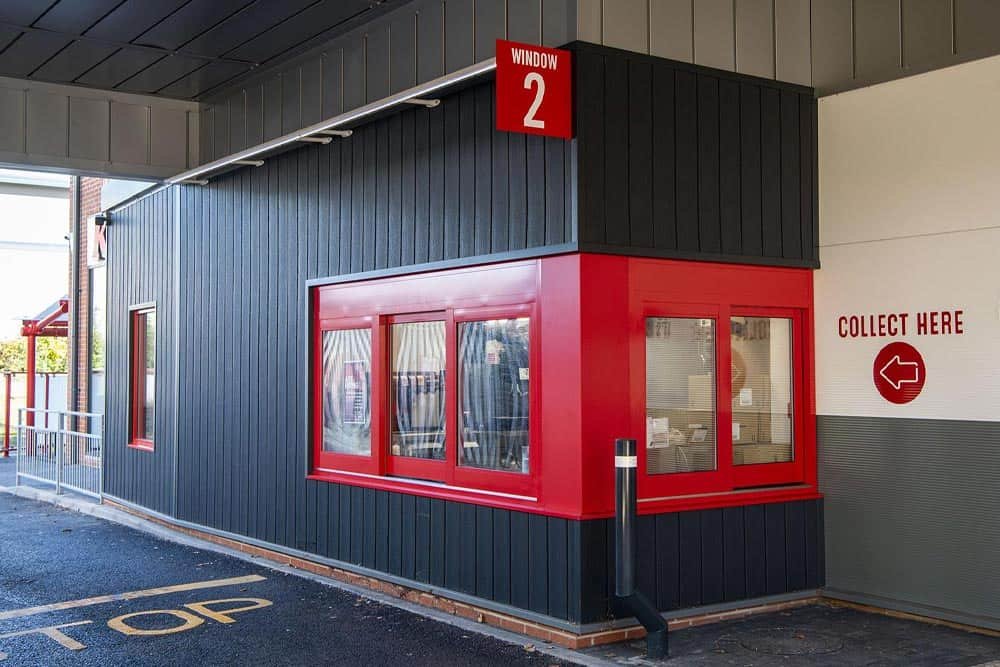
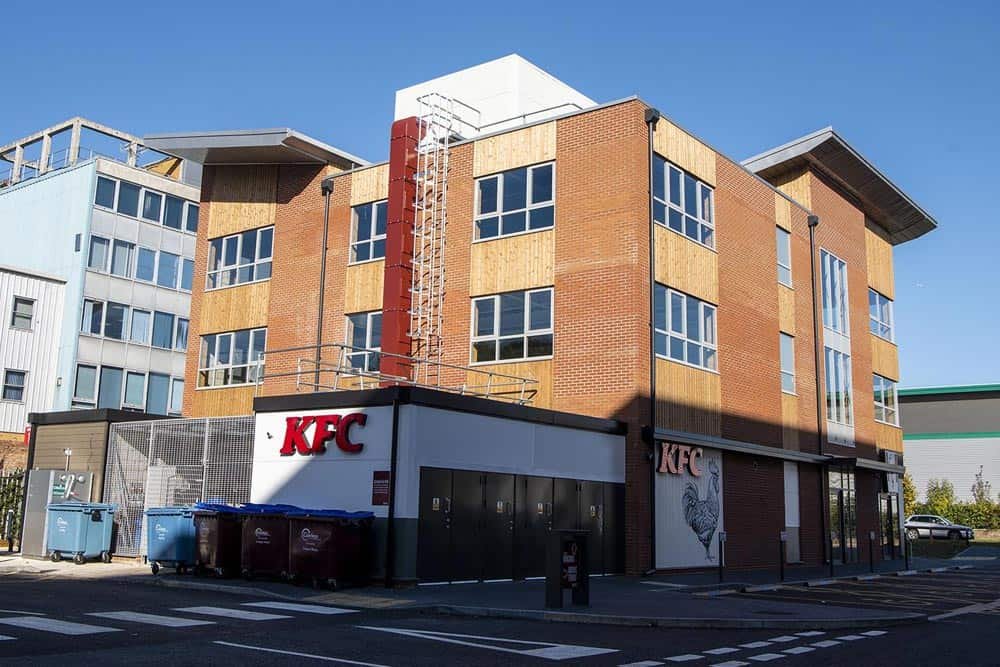

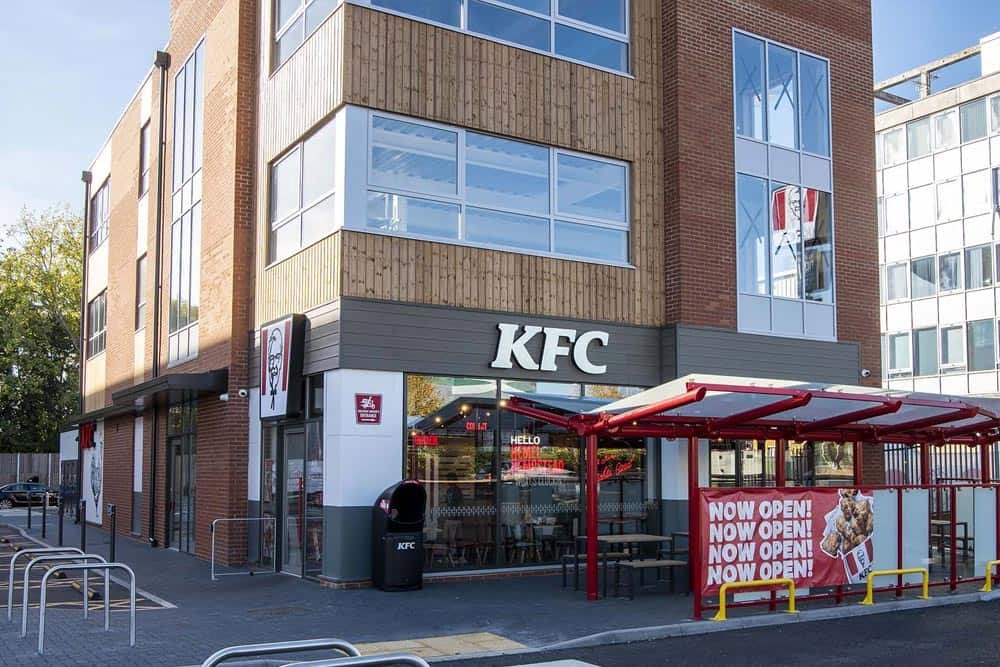
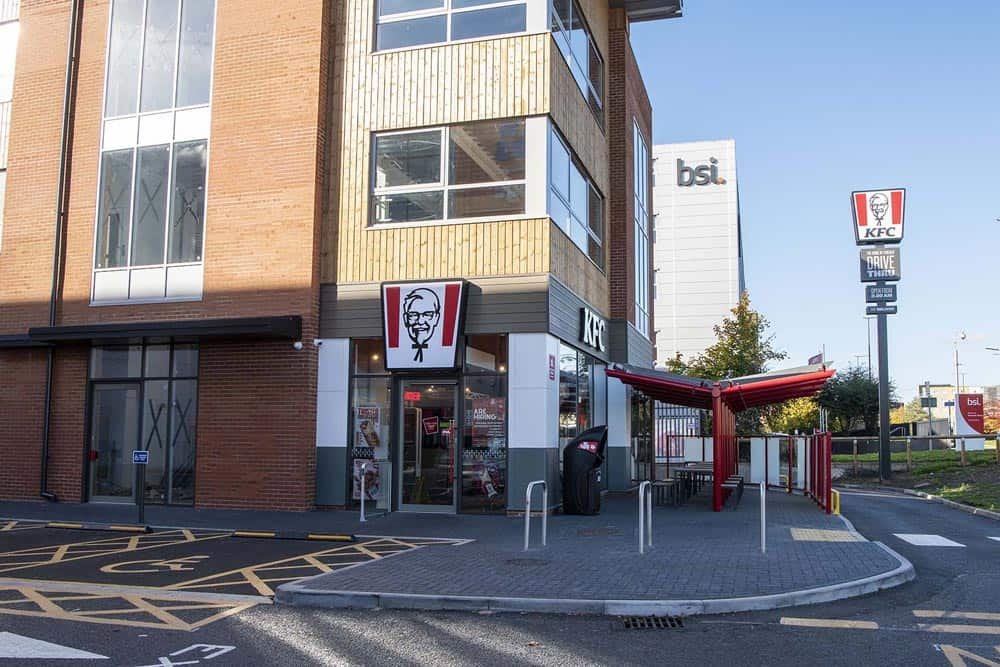
How Curtain Walling Boosts The Appearance Of Any Building
In today’s design led world, it’s become increasingly important for architects and building engineers to design aesthetically beautiful structures both inside and out. Working within the restrictions of a budget and space limitations, having cost friendly options available for the structure of the outside of a building is essential.
Most architects are striving to create modern, minimalist looking buildings that will stand the test of time. For these reasons, the use of aluminium curtain walling is frequently a popular choice.
Here, we explore why.
What is aluminium curtain walling?
An aluminium curtain wall is an external framework, separate from the main construction of a building. It is non structural which provides architects with more design freedom when it comes to the exterior of a building. Also sometimes called façade or curtain glazing, it is a framework constructed from aluminium and glass with no limitations to the size or shape of it’s finished structure.
How and where is it used?
There are two types of curtain walling most commonly used in industry:
Pressure Equalised Systems – this system uses gaskets, pressure plates and external cappings which are designed to provide a finish that is impervious to any moisture.
Face Sealed Systems – this system uses a glass to glass framework whereby utter precision is required when sealing the interface.
Usually, a curtain walling system will rely on aluminium mullions and transoms to support the main structure. The bars that make up the main grid for the walling can come in custom sizes and depths depending on the design.
In the past, aluminium curtain walling would have typically been used for large, public buildings such as shopping centres or office blocks. But in recent years, it has also started being utilised for residential properties and smaller buildings as well. The reason for its use on large buildings is that it has very few design limitations. It’s ability to be used to cover vast exterior spaces means that architects and builders can create buildings that have clean lines and a modern appearance with the benefit of being cost effective too, which we’ll go into more detail about later.
Why aluminium curtain walling?
The transformative qualities that using an aluminium curtain walling possesses is quite remarkable. It’s prevailing use in architecture for nearly 100yrs, is evidence that it remains a popular choice for creating not only functional and durable building exteriors but also stunning ones too – where a designer intends. Because of a curtain walling’s flexibility in terms of size and style, a designer can create structures fabricated solely of glass which is a quality entirely unique to itself.
Added benefits and advantages
In addition to its design appeal, a glass curtain wall has wonderful structural advantages as well. Because it is manufactured out of aluminium, which is a notoriously lightweight material, it can support its own weight efficiently when compared to other building exterior options. This makes the need for expensive additional foundations surplus to requirement, passing on a cost saving benefit to the client. Despite its lightweight character, curtain glazing is substantially stronger than windows alone. On top of this, the systems used to create a glass curtain wall make it fully sealed against the elements. The failsafe weatherproofing that aluminium curtain walling provides means it is a durable, hardy and long lasting way to protect a building.
The aesthetic allure of curtain glazing
Once upon a time, the requirement for a decent amount of daylight within a building may have been considered a frivolous luxury. Nowadays, it’s more or less an essential design stipulation, with exposure to daylight being linked to increased wellbeing and good health. The wealth and quality of light that an aluminium curtain wall affords within a building, is second to none. Indeed, a designer can choose to have the entire exterior of a building constructed just from glass. More frequently, it is used to cover multiple floors or segment between floors. Or sometimes the whole of a side or entrance floor to a building.
Curtain glazing also carries the ability to be used for creating curved shapes to the outside of a building. This sets it apart from other types of materials because not only can it be used in this way, it is also usually an affordable option for most developers who want something special but are working within the limitations of a budget.
Flexibility for a good price
The majority of projects that incorporate the use of an aluminium frames and curtain walling, do so for it’s use of glass. However, other materials can be utilised as well which provides a vast choice for colours, finishes and textures. This makes it hugely appealing for projects where brand integrity is a big consideration.
The fact that facade glazing can look so beautiful, is one of the main reasons that it has started being used more frequently in residential architecture. Light and space are design benefits that more and more homeowners are demanding.
Regardless of the building project, because glass and aluminium can both be budget friendly materials to source, the spectacular design a curtain glazing administers doesn’t need to cost the earth!
The team at Crucial Engineering are a national commercial aluminium fabricator. We manufacture, install and maintain commercial aluminium products to create high quality and secure access solutions. When you work with us you can be sure of a fantastic long term relationship including expert aluminium fabrication services alongside the very best customer service.
A refurbished entrance for Carnaud Metal Box Engineering
Based in Shipley, Carnaud Metal Box Engineering are part of a global network of metal can manufacturers. They design, develop and manufacture high-performance metal forming and finishing machinery for the production of metal cans for beverages, food and aerosols.
Their office building has undergone a recent refurbishment and approached Crucial to discuss a new entrance. Their previous entrance had become tired including unattractive and unfriendly shutters which made quick access impossible. It also had a tired looking curtain wall with glazing that presented a dark and unwelcoming interior.
The company has ambitious targets and how they present themselves to both staff and customers is important if they are to take advantage of all market opportunities.
The Crucial team worked with them to create a plan to remove the old roller shutters and curtain wall. We created and engineered a new building entrance which included a modern and fresh staff entrance. We added automatic entrance doors to create a welcoming exterior that allows staff to easily come and go. We also installed a new curtain wall with floor-to-ceiling glazing. The new glazing on all sides creates a bright and airy environment by allowing large amounts of natural light to pass through.
We were also able to include their company colour throughout the entrance to solidify their brand personality and professionalism.
Crucial Engineering are proud to work with commercial and industrial customers all over the UK. We’re experts in aluminium and Automation specialising in creating secure and professional access and entrance solutions. From automatic doors and glazing through to curtain walling systems, roller shutters, barriers and gates our team can help.


The Practical Benefits Of Aluminium Curtain Walling
The concept of aluminium curtain walling installation may be something unknown to you but it’s likely you see examples of this type of structure every day. A curtain wall can give any commercial building or modern architecture an eye-catching appearance whilst also bringing a series of practical advantages.
Previously many curtain walls were made from steel but are now made from aluminium because it’s lightweight. The curtain wall is then completed with glass or other materials to create a great looking building.
We’ve taken a look at a series of practical benefits of aluminium curtain walling:
Protect building structures from the elements
A curtain wall is non-structural so separate from the building itself and whilst any building should keep out the wind and rain, a curtain wall adds a layer of protection. It should insulate as well as block out the elements, and due to their cost effective maintenance they are ideal for locations with heavier rainfall.
Add attractive design to any building
Obviously the extra protection is more important but the fact that an aluminium curtain wall adds fantastic looks make them extremely popular with architects and building designers.
Adding a curtain wall will instantly create the look of an incredibly modern building with clean lines and flexible finishes. This along with the fact it’s lightweight means building designers have freedom to create imaginative structures. No matter if you’re designing a curved building, one with interesting angles or need classic straight lines, aluminium curtain walling is flexible enough to bring it to life.
In addition, if you’re wanting to create a totally unique look you can look to use a range of materials and shapes within your curtain walling. For example, you may choose to use coloured or shaped glass, or use triangles rather than the usual square or rectangles.
Allow large amounts of natural light to pass through
Natural light is always an important consideration in any building design. It doesn’t matter what the building’s purpose is, any building from office blocks to retail spaces, strive for natural light to create uplifting environments.
Plus, large amounts of natural light will also save on energy costs from artificial lighting. Large bright and airy spaces will also increase the value of the building as the space will instantly become more attractive to buyers or tenants.
In environments where large amounts of bright sunshine can be expected, a curtain wall can be fitted with glass with UV filters to protect the contents inside. This is ideal for buildings containing items of historical importance such as museums.
Depending on the design of the building structure, introducing opportunities to allow large amounts of natural light can be complex. This is where aluminium curtain walls are so useful as it’s relatively simple to add a lot of glazing for light to pass through.
Add insulating properties
We’ve already discussed how curtain walling is great at keeping the elements out, but they’re also amazing insulators which makes it easier to regulate inside temperatures. This further adds long term cost savings through reduced energy compared to more traditional building methods.
Prevent quick spread of fire
In the unlikely event of a disaster such as a fire a curtain wall will help prevent the spread, especially in taller buildings. Fires often spread from floor to floor on the outside surface and a curtain wall made from aluminium, complete with large amounts of glass, will at a minimum reduce the rate at which the fire is spreading.





